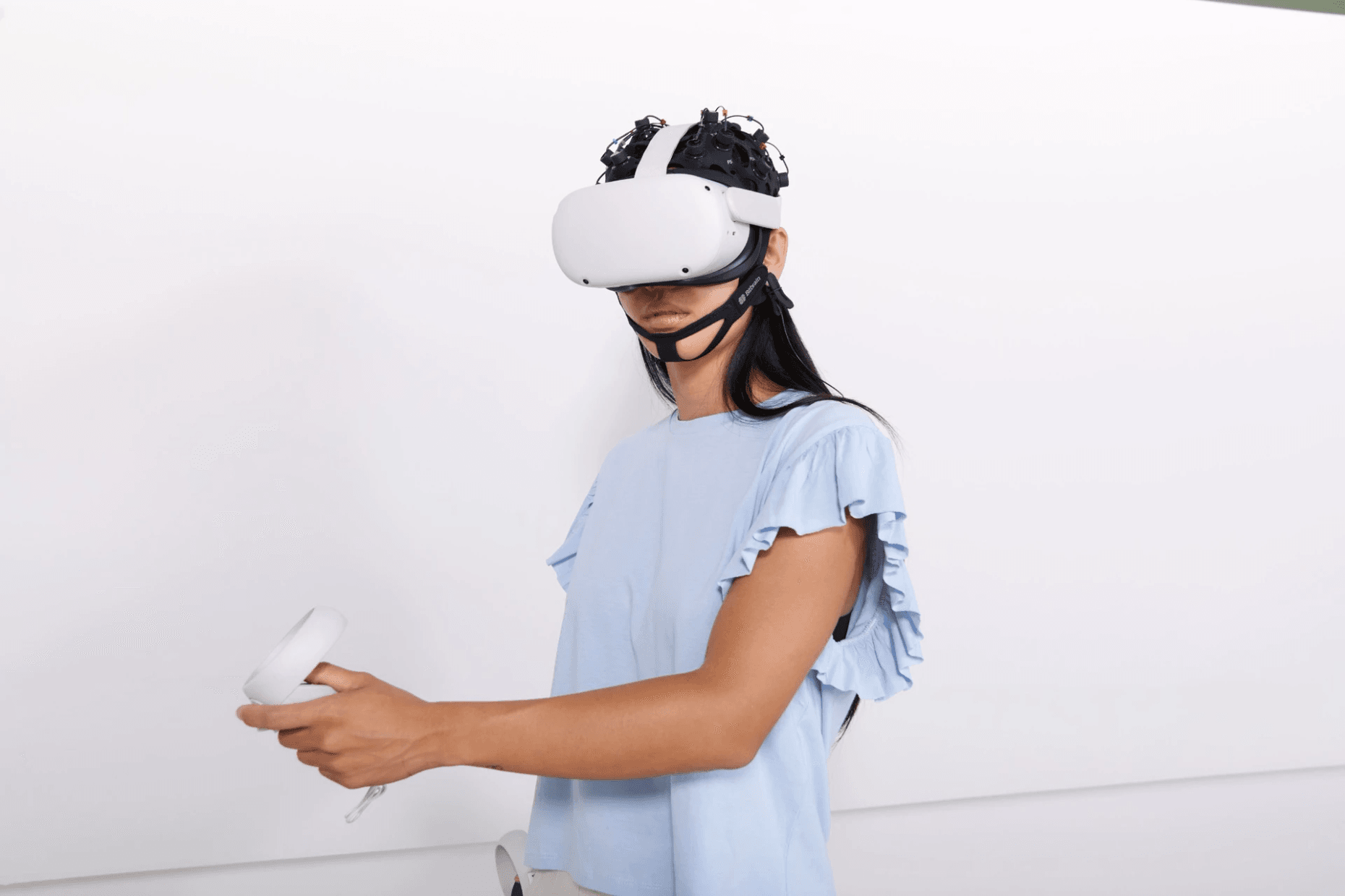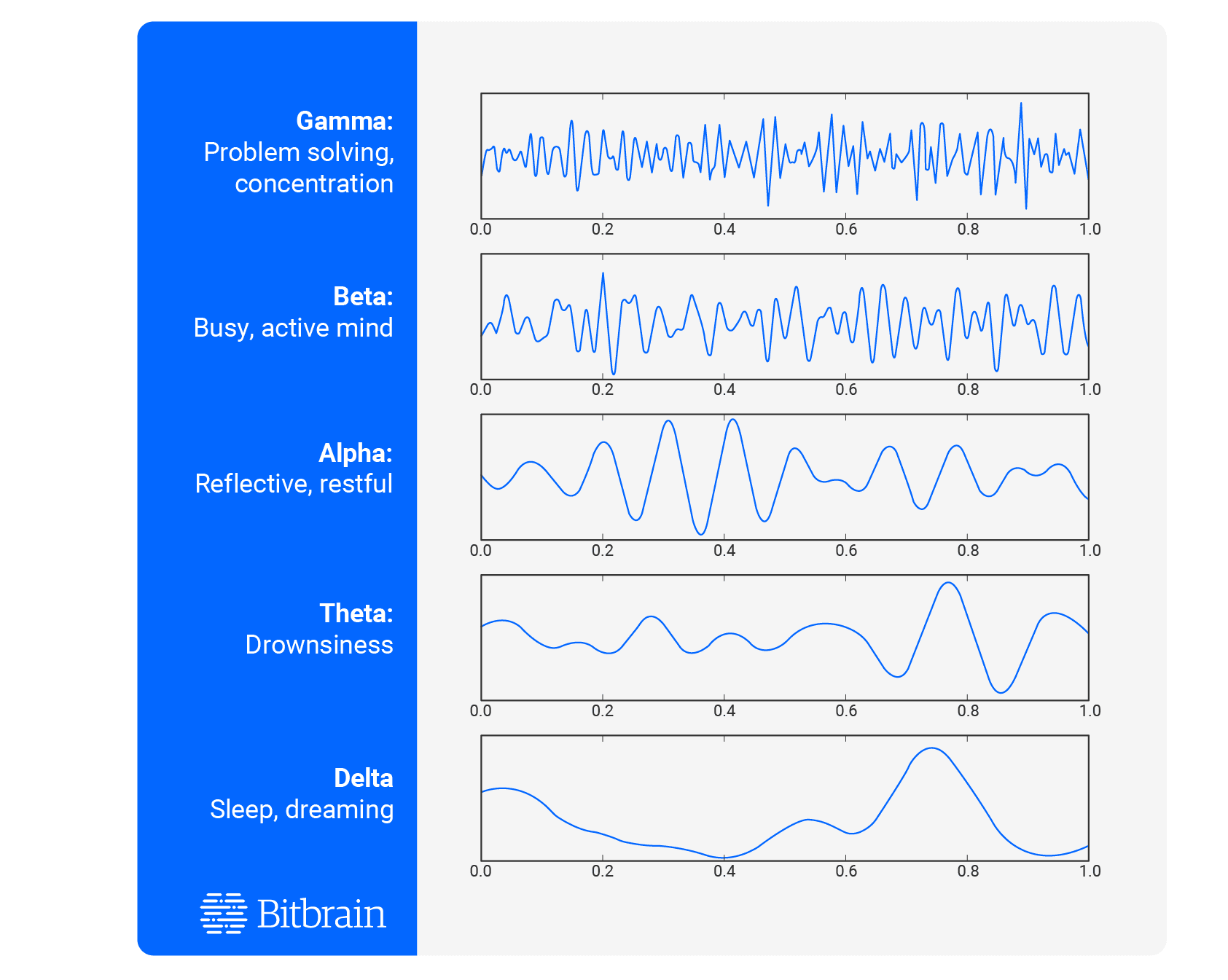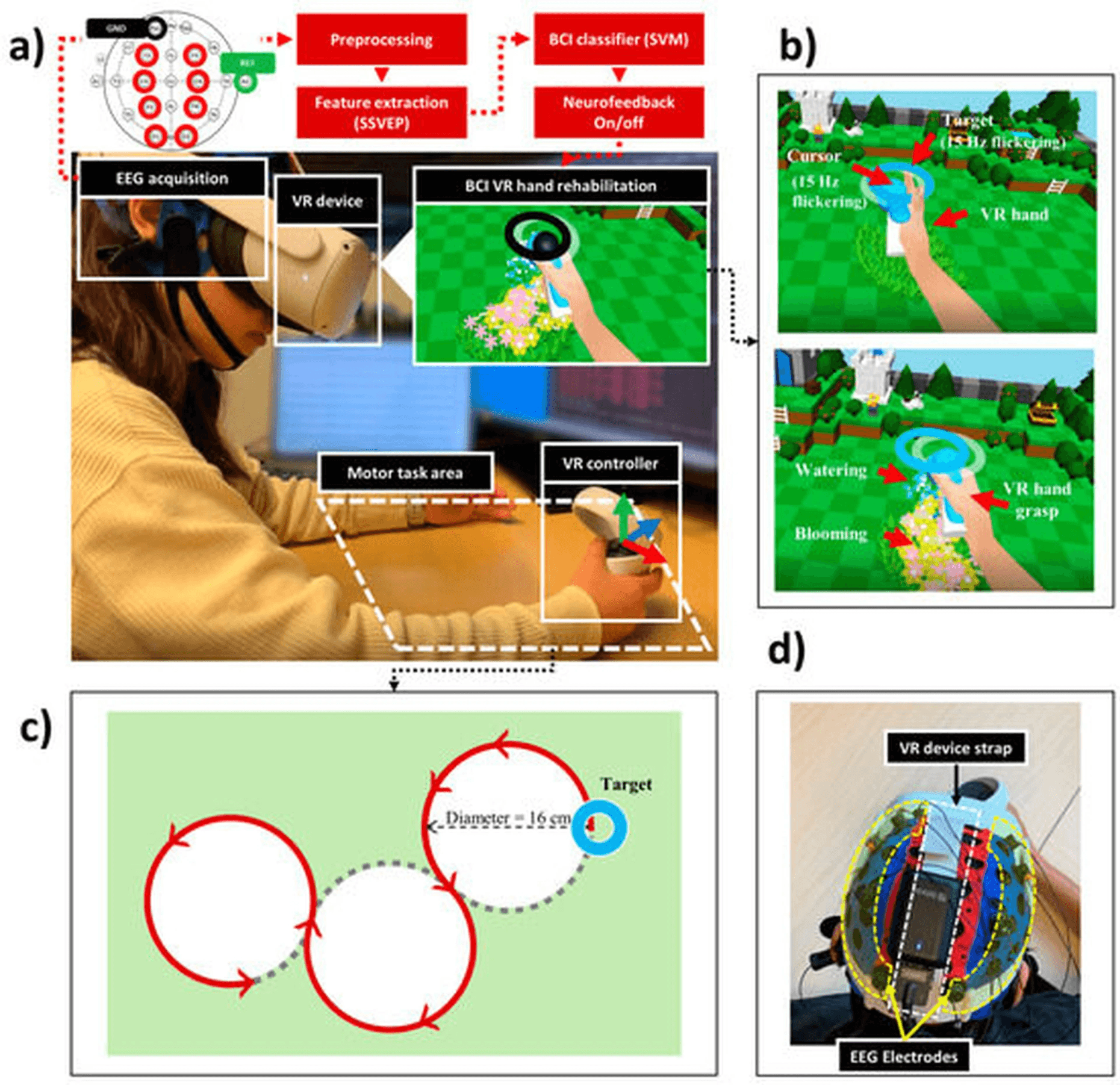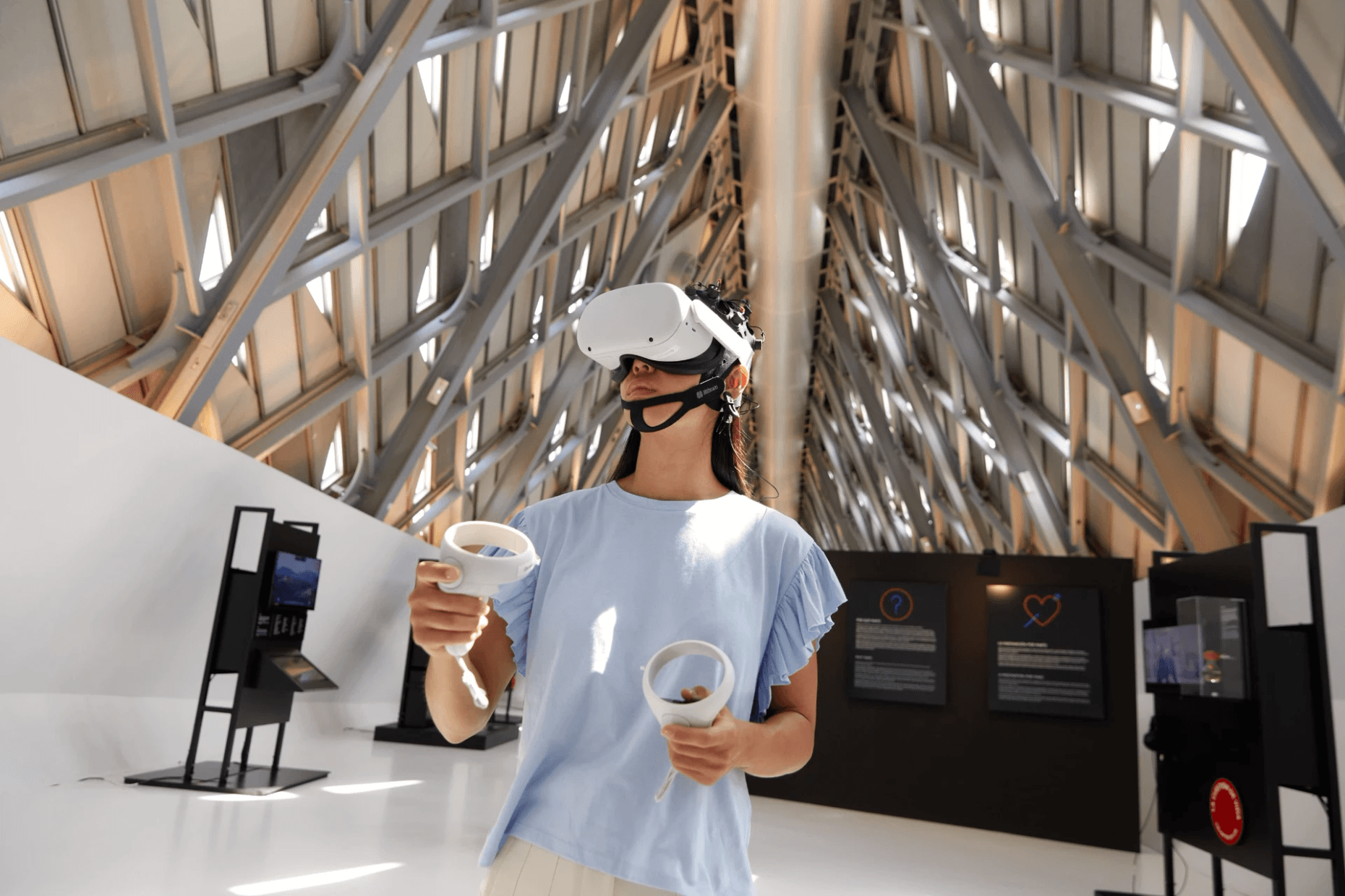EEG and Virtual Reality: The Neuroadaptive Future of Neurotechnology
Can technology truly read our thoughts and emotions, and adapt the digital world in real time? What once belonged to science fiction is now possible, thanks to the convergence of electroencephalography (EEG) and virtual reality (VR). This fusion enables us not only to measure attention, emotion, and cognitive fatigue, but also to personalize digital experiences in real-time, fundamentally redefining human–machine interaction.
With recent advances in portable EEG and VR technology, it is now possible to access and respond to a user’s brain state in real-time. This breakthrough is already enabling personalized rehabilitation, adaptive gaming, cognitive training, and clinical diagnostics, laying the groundwork for a new generation of neurotechnology solutions (Li, 2024).

Over the last five years, the emergence of portable, accessible, and ergonomic devices has democratized access to brain monitoring outside the laboratory. Clinical cases such as post-stroke rehabilitation guided by BCI-VR, personalized gaming via neurofeedback, and stress measurement in work environments using smart helmets are now validated by scientific studies (Vaquero-Blasco, 2021; Tehrani, 2022). The economic and social impact is undeniable: from lowering the cost of personalised therapies to optimizing professional training and designing user-adapted products.
EEG and VR in Context
EEG is a non-invasive technique that records the brain’s electrical activity through sensors placed on the scalp. This technology captures neural oscillations across different frequency bands—delta, theta, alpha, beta, and gamma—which are associated with various cognitive, emotional, and motor states.

VR is a technology that creates immersive three-dimensional digital environments, generating in the user a sensation of being “present” in an artificial space through visual, auditory, and sometimes haptic stimulation. Modern VR headsets (Head-Mounted Displays, HMDs) such as Oculus Quest, HTC Vive, or PlayStation VR integrate high-resolution screens, motion sensors, and spatial audio to maximise realism and interaction.
VR is disruptive due to its ability to create realistic and controlled situations, which are ideal for experimenting, training, and measuring behaviours, emotions, and cognitive responses in a natural yet reproducible manner. As a result, VR has evolved significantly beyond entertainment, establishing itself as a leading platform for medical simulation, industrial training, psychological therapy, neurological rehabilitation, and advanced neuroscience research.
Miniaturisation, Portability, and Affordability
Over the past five years, advances in miniaturisation, cost reduction, and materials science have revolutionised VR-EEG systems. Once limited to bulky laboratory setups with hard-to-maintain wet electrodes, EEG recording is now possible with dry and flexible electrodes made from conductive polymers, smart textiles, or silicone, providing comfortable and reliable brain signal monitoring, even outside clinical settings or during movement.
The dramatic drop in the cost of HMDs has promoted collaborative research and rapid innovation. At the same time, wireless systems with Bluetooth connectivity and advanced synchronization allow for real-time EEG data acquisition and multimodal setups (integrating eye tracking, EMG, GSR, and heart rate sensors). These improvements have made VR-EEG accessible for applications in mental health, education, digital art, gaming, and behavioural sciences.
For the first time, VR is genuinely accessible to both the general public and professionals, thanks to lighter, more powerful, and affordable devices with precise tracking and haptic controllers; open standards like Unity and Unreal Engine that accelerate application development; and seamless integration of biometric sensors for synchronization with wearable devices.
Why Does It Matter Now? Clinical, Scientific, and Social Relevance
The integration of VR-EEG is driving a revolution on four major fronts:
- Basic Science and Neurocognition:
This technology enables the study of emotions, decision-making, attention, and learning within naturalistic, controlled, and reproducible environments—something unimaginable with traditional 2D paradigms or laboratory-only setups. By leveraging immersive VR, researchers can now investigate complex brain processes under conditions that closely mimic real-life scenarios. - Personalized Medicine and Wellbeing:
VR-EEG supports the development of neuroadaptive therapies, the monitoring of neuromotor rehabilitation, early intervention for cognitive fatigue, and personalized neurofeedback for conditions like anxiety, ADHD, or chronic pain (Lim, 2024). The capacity to tailor interventions to an individual’s real-time brain activity represents a paradigm shift in digital health and mental wellness. - Industrial and Educational Innovation:
From smart helmets in construction that continuously monitor worker fatigue in real time, to educational simulators that dynamically adjust difficulty based on a learner’s neural engagement, VR-EEG is optimizing both training outcomes and safety (Ji, 2023; Cao, 2025). This neuroadaptive technology is already influencing workforce development and next-generation learning. - Democratisation and Ethics:
The portability and affordability of modern systems enable brain monitoring “in the real world,” far beyond specialist labs. However, this brings new challenges and opportunities related to privacy, informed consent, and user-centred design (Wexler, 2019). Addressing these issues is crucial to ensure that neurotechnology is developed and deployed ethically and equitably.
Hardware, Sensors, and Core Challenges
Wearable EEG Headsets
Wireless and lightweight, wearable EEG systems have made real-time brain monitoring broadly accessible. Using either water-based or dry electrodes, they allow users to measure and track brain activity in naturalistic environments with minimal preparation. When combined with VR technology, wearable EEG can play an important role. For example, Bitbrain’s Versatile EEG provides high-quality signals with minimal movement artefacts, offering gel-free usability that saves setup time without compromising data quality.
A practical illustration of this comes from Lim et al. (Keimyung University, South Korea), who used Bitbrain’s water-based Versatile 8-channel system in their study “Brain-Computer Interface Based Engagement Feedback in Virtual Reality Rehabilitation: Promoting Motor Cortex Activation.” In their experimental setup, a participant wearing the EEG headset and VR display performed a target-tracking task using a handheld controller. EEG data were recorded and processed in real time, delivering neurofeedback on whether the participant was attentively focusing on the flickering target.

Textile-EEG headbands, such as Bitbrain Ikon EEG, further reduce setup time and increase comfort. However, they typically offer slightly lower signal quality, with more susceptibility to motion artefacts, and are limited to frontal cortex recordings. While less suitable for high-fidelity research or clinical applications, their affordability, portability, and compatibility with mobile apps have driven widespread adoption in daily life, wellness, and educational contexts.
Integrated VR-EEG Systems
VR headsets with embedded EEG expand signal coverage and enable multimodal analysis, with electrodes spanning frontal, parietal, and occipital regions. These systems often incorporate additional sensors (e.g., EMG, EOG, GSR, heart rate) to provide a more comprehensive view of the user’s state. This enables precise and synchronized studies of emotions, cognition, and physiological responses, supporting both advanced research and adaptive environments. Innovations in electrode design—such as pillar, textile, and in-ear sensors—improve comfort and recording quality, even in areas with hair coverage. Wireless operation and compact form factors further support use in dynamic, real-world contexts.
Technical Challenges and Practical Limitations
Despite the progress of both approaches, several technical and practical barriers persist:
- Comfort and Electrode Stability: Achieving stable, comfortable electrode contact, especially over extended sessions or in areas with hair coverage, remains a significant engineering challenge. Pressure from the headset can impact both comfort and data quality (Wang, 2022).
- Cost and Scalability: Advanced systems are more expensive and often require specialized infrastructure, which can hinder mass adoption.
- Synchronization and Data Processing: Wireless data transmission, real-time integration of multiple biosignals, and standardization of protocols all demand robust algorithms and industry standards that are still under development.
- Signal Quality and Artifacts: While high-density, multimodal systems offer richer data, they are also more vulnerable to movement, electrical noise, and user variability, requiring sophisticated artifact removal and processing.
Innovative electrode materials and designs now enable the collection of high-quality neural data, even from hair-covered or hard-to-reach regions. Wireless, compact setups support unrestricted movement and ecologically valid simulations. Such versatility enables these systems to be utilized across various applications, including clinical neurorehabilitation, cognitive testing, avatar and robot control, neuroergonomics, and advanced training simulators.
Recent Innovations in Sensors and Hardware
Microstructured, Dry, and Flexible Electrodes
Next-generation sensors (e.g., pillar, textile, and conductive sponge types) maintain excellent conductivity and stability, even in hair-covered areas, while minimizing discomfort and skin irritation. The use of PEDOT: PSS materials, for example, as in systems like Cognixion One, supports continuous and reliable EEG recordings both at rest and during immersive VR, paving the way for clinical and assistive applications (Li, 2024).
In-Ear and Around-the-Ear Electrodes
Sensors positioned in or around the ear capture brain signals from the temporal and mastoid regions without interfering with VR headsets, allowing for natural and comfortable monitoring in mobile, social, or clinical settings (Xu, 2023).
Intelligent Processing Platforms
New real-time processing and visualization systems, such as Cognixion’s Axon-R, use AI to filter artifacts, synchronize brain signals with environmental events, and personalize the user experience. Reliable wireless connectivity and synchronization now support closed-loop applications, where brain feedback can dynamically adjust the VR experience or device responses in real-time. Robust wireless connectivity and advanced synchronization have become critical, enabling “closed-loop” applications where real-time brain feedback dynamically adjusts the VR experience or the responses of assistive systems. These innovations not only enhance the quality and stability of EEG recordings but also enable new models of human–technology interaction, including personalized rehabilitation, assistive communication, and emotional well-being.
Commercially Integrated VR-EEG Systems: Current Landscape and Challenges

The direct integration of EEG sensors into VR headsets represents a significant step forward compared to earlier approaches, which required a separate EEG cap worn beneath a visor, often causing discomfort and complicating the collection of real-world data. Today’s commercial VR-EEG systems offer fast setup, better comfort, and a superior immersive experience, proving their value in both healthcare and entertainment (Cassani, 2020).
Dry electrodes embedded in frontal padding are convenient for tracking emotional and cognitive states. Still, they have limitations: they are susceptible to muscle and ocular artefacts, and they do not record from hair-covered regions, which are crucial for advanced BCI tasks (Cassani, 2020; Zhang, 2021).
Innovative “pillar” electrodes now allow measurement from parietal and occipital regions, supporting complex BCI tasks like SSVEP or P300 (Li, 2023). Recent advances also support multimodal sensing, with the integration of EMG, EOG, GSR, and PPG sensors to monitor a user’s emotional state, attention, and stress in real time.
Many commercial systems now feature integrated sensors for EMG, EOG, GSR, and heart rate, enabling rich, real-time monitoring of a user's emotional and physiological states. Some devices employ rigid pin meshes to capture signals from multiple brain regions; when combined with facial sensors, this setup provides nuanced insights into users’ emotional expressions and engagement during immersive VR experiences (Cassani, 2020).
However, for the sake of convenience and rapid setup, most commercial headsets still rely on dry electrodes. While advances in conductive polymers enable signal collection even from hairy scalp regions, these electrodes often exhibit higher contact impedance and are more sensitive to movement. This can lower the signal-to-noise ratio and requires built-in amplifiers, which add both weight and power demands to the device (Li, 2023).
Innovation in Electrodes and Materials
Ongoing research is focused on developing electrode materials and designs that enhance comfort, signal stability, and compatibility with hair, persistent challenges for VR-EEG systems. For example, conductive textile electrodes with nickel/copper nanoparticle fibres offer greater flexibility and comfort at a lower cost (Zhang, 2021). However, their inability to penetrate hair limits their use on scalp regions covered by hair.
Pillar-shaped electrodes made from advanced conductive polymers, such as PEDOT: PSS, offer improved conformity and contact with thin hair, thereby enhancing signal quality and user experience (Li, 2023). Meanwhile, flexible microneedles and hydrogel electrodes formed directly on the skin can deliver low impedance and comfort; however, their broader adoption is still limited by concerns over biocompatibility and infection (Wang, 2022).
Persistent Limitations and Integration Challenges
Despite significant advances, several persistent challenges hinder the widespread adoption and clinical translation of VR-EEG systems. Dry electrodes, though more convenient for users, frequently struggle with hair compatibility, often causing discomfort, higher impedance, and increased susceptibility to motion artefacts—factors that undermine long-term data quality (Cassani, 2020; Li, 2023).
Physical integration also remains complex; achieving stable and reliable scalp contact without applying excessive pressure requires a delicate balance between ergonomic headset design, light isolation, and maintaining high signal quality. In addition, limited electrode coverage is a common constraint, as most commercial systems monitor only select regions such as the prefrontal, parietal, and occipital areas, thereby restricting their usefulness for advanced neuroimaging or comprehensive clinical applications.
Finally, wireless synchronization presents its own hurdles, with fully wireless systems requiring robust data transmission protocols and precise event synchronisation, both of which are essential for accurate, real-time, and closed-loop brain–computer interface operations.
Multimodality, Synchronization, and Closed-Loop Systems
The next generation of commercial VR-EEG systems is moving beyond the simple recording of brain activity. By integrating multimodal sensing—combining EEG with eye tracking, EMG, EOG, GSR, heart rate, and other biosensors—these platforms can provide a more holistic understanding of the user’s cognitive, emotional, and physiological state (Cassani, 2020).
The multimodal approach is further enhanced by VR headset sensors, including gyroscopes, accelerometers, cameras, and microphones, which allow for the simultaneous measurement of both physiological and behavioural responses. Combining the high temporal resolution of EEG with modalities like fNIRS for spatial precision or in-ear sensors for convenient monitoring helps overcome the traditional limitations of scalp EEG and enables more context-aware interpretations.
Synchronisation between all these signals and the VR environment is essential. Accurate time alignment ensures meaningful data fusion, as even minor jitters can undermine the reliability of multimodal analysis. This requires precise hardware timing, stable reference crystals, and software-based wireless synchronization, ensuring full compatibility with VR development platforms such as Unity or OpenVR.
At the frontier of this evolution are closed-loop VR-EEG systems. These platforms decode brain activity in real-time, using it to adapt the virtual environment or provide direct feedback to the user. This paradigm is already transforming neurorehabilitation, cognitive training, and immersive entertainment. In clinical contexts, closed-loop neurofeedback and neurostimulation can boost brain plasticity, supporting personalized recovery after stroke or brain injury (Wang, 2022; Hao, 2022).
Moreover, as artificial intelligence advances, we can expect VR-EEG systems to become increasingly intelligent, personalising experiences, optimising therapy protocols, and supporting remote interventions via telehealth. For developers, the challenge is to design decoders and interfaces that are both user-friendly and responsive, ensuring that brain-computer interfaces (BCI) become truly accessible, impactful, and adaptive to individual needs.
References
Li, H., Shin, H., Sentis, L., Siu, K.-C., Millán, J. del R., & Lu, N. (2024).
Combining VR with electroencephalography as a frontier of brain computer interfaces. Device, 2(6), 100425. https://doi.org/10.1016/j.device.2024.100425
Vaquero-Blasco, M. A., López-Gil, J. M., Pastor, J. M., & López, M. T. (2021).
Quantitative assessment of stress through EEG during a virtual reality stress-relax session. Sensors, 21(6), 2219. https://doi.org/10.3390/s21062219
Tehrani, B. M., Wang, J., & Truax, D. (2022).
Assessment of mental fatigue using electroencephalography (EEG) and virtual reality (VR) for construction fall hazard prevention. Engineering, Construction and Architectural Management, 29(9), 3593–3616. https://doi.org/10.1108/ECAM-01-2021-0017
Lim, H., Ahmed, B., & Ku, J. (2025).
Brain-computer interface based engagement feedback in virtual reality rehabilitation: Promoting motor cortex activation. Electronics, 14(5), 827. https://doi.org/10.3390/electronics14050827
Ji, L., Zhang, C., Li, H., Zhang, N., Guo, C., Zhang, Y., & Tang, X. (2023).
A comprehensive experimental framework based on analysis of the pilot's EEG and NASA-TLX questionnaire in a VR environment. Proceedings of the Institution of Mechanical Engineers, Part H: Journal of Engineering in Medicine, 237(7), 869–878. https://doi.org/10.1177/09544119231179842
Cao, J., & Luo, H. (2025).
Combining virtual reality and EEG biofeedback for enhanced EFL learning: A sociocultural approach. Education and Information Technologies. https://doi.org/10.1007/s10639-025-13348-4
Wexler, A., & Thibault, R. (2019).
Mind-reading or misleading? Assessing direct-to-consumer electroencephalography (EEG) devices marketed for wellness and their ethical and regulatory implications. Journal of Cognitive Enhancement, 3, 131–137. https://doi.org/10.1007/s41465-018-0091-2
Wang, C., Wang, H., Wang, B., Miyata, H., Wang, Y., Nayeem, M. O. G., Kim, J. J., Lee, S., Yokota, T., Onodera, H., & Someya, T. (2022).
On-skin paintable biogel for long-term high-fidelity electroencephalogram recording. Science Advances, 8(20), eabo1396. https://doi.org/10.1126/sciadv.abo1396
Xu, Y., De la Paz, E., Paul, A., Mahato, K., Sempionatto, J. R., Tostado, N., Lee, M., Hota, G., Lin, M., Uppal, A., ,. (2023).
In-ear integrated sensor array for the continuous monitoring of brain activity and of lactate in sweat. Nature Biomedical Engineering, 7, 1307–1320. https://doi.org/10.1038/s41551-023-01095-1
Cassani, R., Moinnereau, M. A., Ivanescu, L., Rosanne, O., & Falk, T. H. (2020).
Neural interface instrumented virtual reality headsets: Toward next-generation immersive applications. IEEE Systems, Man, and Cybernetics Magazine, 6(2), 20–28. https://doi.org/10.1109/msmc.2019.2953627
Zhang, Y., Zhang, L., Hua, H., Jin, J., Zhu, L., Shu, L., Xu, X., Kuang, F., & Liu, Y. (2021).
Relaxation degree analysis using frontal electroencephalogram under virtual reality relaxation scenes. Frontiers in Neuroscience, 15, 719869. https://doi.org/10.3389/fnins.2021.719869
Li, H., Shin, H., Zhang, M., Yu, A., Huh, H., Kwon, G., Riveira, N., Kim, S., Gangopadahyay, S., Peng, J., ,. (2023).
Hair-compatible sponge electrodes integrated on VR headset for electroencephalography. Soft Science, 3, 21. https://doi.org/10.20517/ss.2023.11
Hao, J., Xie, H., Harp, K., Chen, Z., & Siu, K. C. (2022).
Effects of virtual reality intervention on neural plasticity in stroke rehabilitation: A systematic review. Archives of Physical Medicine and Rehabilitation, 103(3), 523–541. https://doi.org/10.1016/j.apmr.2021.06.024
